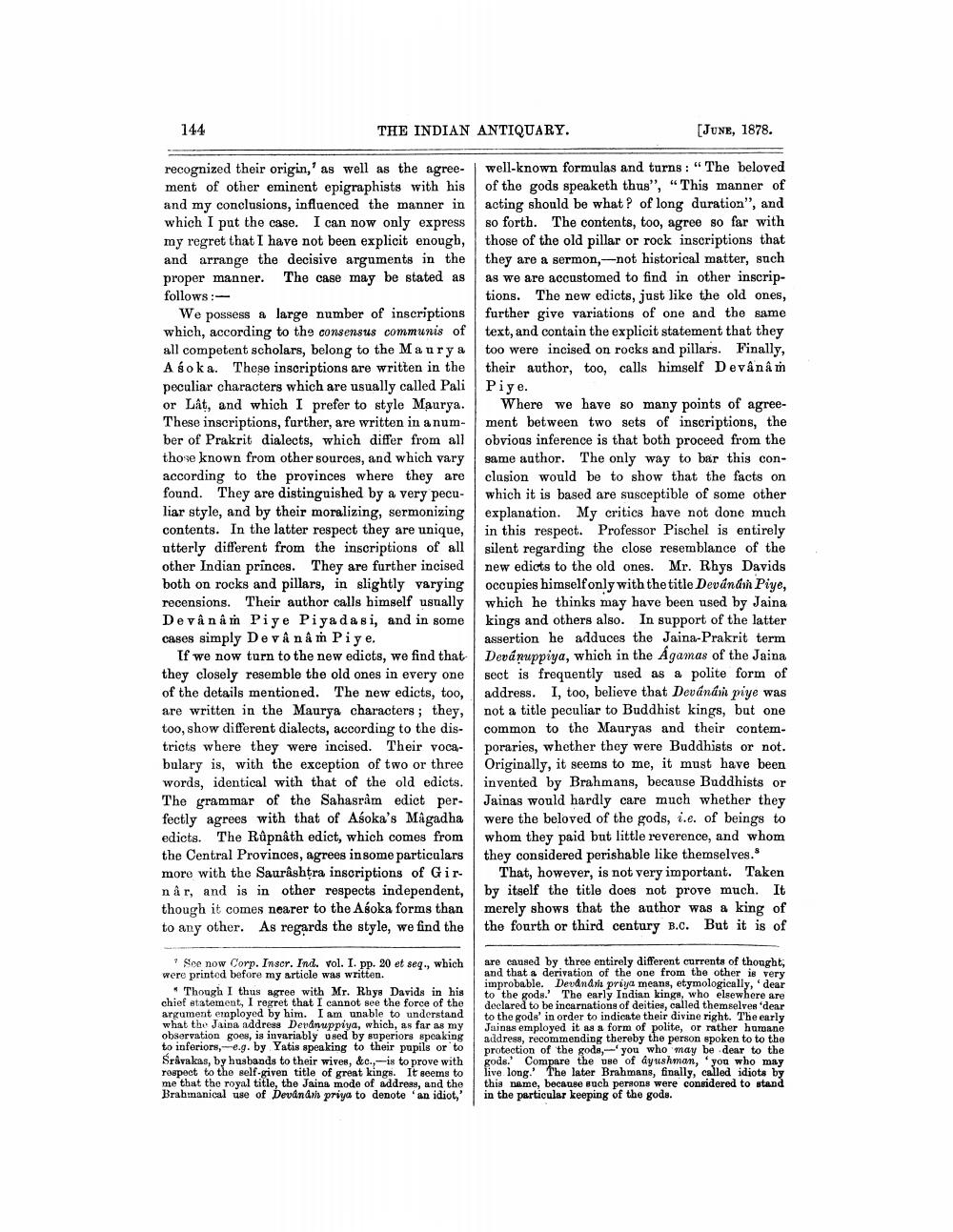________________
144
THE INDIAN ANTIQUARY.
[JUNE, 1878.
recognized their origin,' as well as the agree- ment of other eminent epigraphists with his and my conclusions, influenced the manner in which I put the case. I can now only express my regret that I have not been explicit enough, and arrange the decisive arguments in the proper manner. The case may be stated as follows:
We possess a large number of inscriptions which, according to the consensus communis of all competent scholars, belong to the Maury a A soka. These inscriptions are written in the peculiar characters which are usually called Pali
elly called Pali or Låt, and which I prefer to style Maurya. These inscriptions, further, are written in a number of Prakrit dialects, which differ from all those known from other sources, and which vary according to the provinces where they are found. They are distinguished by a very peculiar style, and by their moralizing, sermonizing contents. In the latter respect they are unique, utterly different from the inscriptions of all other Indian princes. They are further incised both on rocks and pillars, in slightly varying recensions. Their author calls himself usually De vân âm Piye Piyadasi, and in some cases simply Devå nam Piye.
If we now turn to the new edicts, we find that they closely resemble the old ones in every one of the details mentioned. The new edicts, too, are written in the Maurya characters; they, too, show different dialects, according to the districts where they were incised. Their vocabulary is, with the exception of two or three words, identical with that of the old edicts. The grammar of the Sahasråm edict per. fectly agrees with that of Asoka's Magadha edicts. The Rûpnåth edict, which comes from the Central Provinces, agrees in some particulars more with the Saurashtra inscriptions of Gir. nar, and is in other respects independent, though it comes nearer to the Asoka forms than to any other. As regards the style, we find the
well-known formulas and turns : " The beloved of the gods speaketh thus", "This manner of acting should be what ? of long duration", and so forth. The contents, too, agree so far with those of the old pillar or rock inscriptions that they are a sermon,--not historical matter, such as we are accustomed to find in other inscriptions. The new edicts, just like the old ones, further give variations of one and the same text, and contain the explicit statement that they too were incised on rocks and pillars. Finally, their author, too, calls himself Devânâ Piye.
Where we have so many points of agreement between two sets of inscriptions, the obvious inference is that both proceed from the same author. The only way to bar this conclusion would be to show that the facts on which it is based are susceptible of some other explanation. My critics have not done much in this respect. Professor Pischel is entirely silent regarding the close resemblance of the new edicts to the old ones. Mr. Rhys Davids occupies himselfonly with the title Devánán Piye, which he thinks may have been used by Jaina kings and others also. In support of the latter assertion he adduces the Jaina-Prakrit term Devánuppiya, which in the Agamas of the Jaina sect is frequently used as a polite form of address. I, too, believe that Devánari piye was not a title peculiar to Buddhist kings, but one common to the Mauryas and their contemporaries, whether they were Buddhists or not. Originally, it seems to me, it must have been invented by Brahmans, because Buddhists or Jainas would hardly care much whether they were the beloved of the gods, i.e. of beings to whom they paid but little reverence, and whom they considered perishable like themselves.
That, however, is not very important. Taken by itself the title does not prove much. It merely shows that the author was a king of the fourth or third century B.C. But it is of
See now Corp. Inscr. Ind. vol. I. pp. 20 et seq., which were printed before my article was written.
Though I thus agree with Mr. Rhys Davids in his chief statement, I regret that I cannot see the force of the argument employed by him. I am unable to understand what the Jaipa address Devonuppiya, which, as far as my observation goes, is invariably used by superiors speaking to inferiors, e.g. by Yatis speaking to their pupils or to Sravakas, by husbands to their wives, &c.,-is to prove with rospect to the self-given title of great kings. It seems to me that the royal title, the Jaina mode of address, and the Brahmanical use of Devandni priya to denote 'an idiot,'
are caused by three entirely different currents of thought, and that a derivation of the one from the other is very improbable. Devändni priya means, etymologically, 'dear to the gods. The early Indian kinge, who elsewhere are declared to be incarnations of deities, called themselves 'dear to the gods' in order to indicate their divine right. The early Jainas employed it as a form of polite, or rather humane address, recommending thereby the person spoken to to the protection of the gode, you who may be dear to the gode. Compare the use of ayushman, you who may live long. The later Brahmans, finally, called idiots by this name, because such peraons were considered to stand in the particular keeping of the gods.




